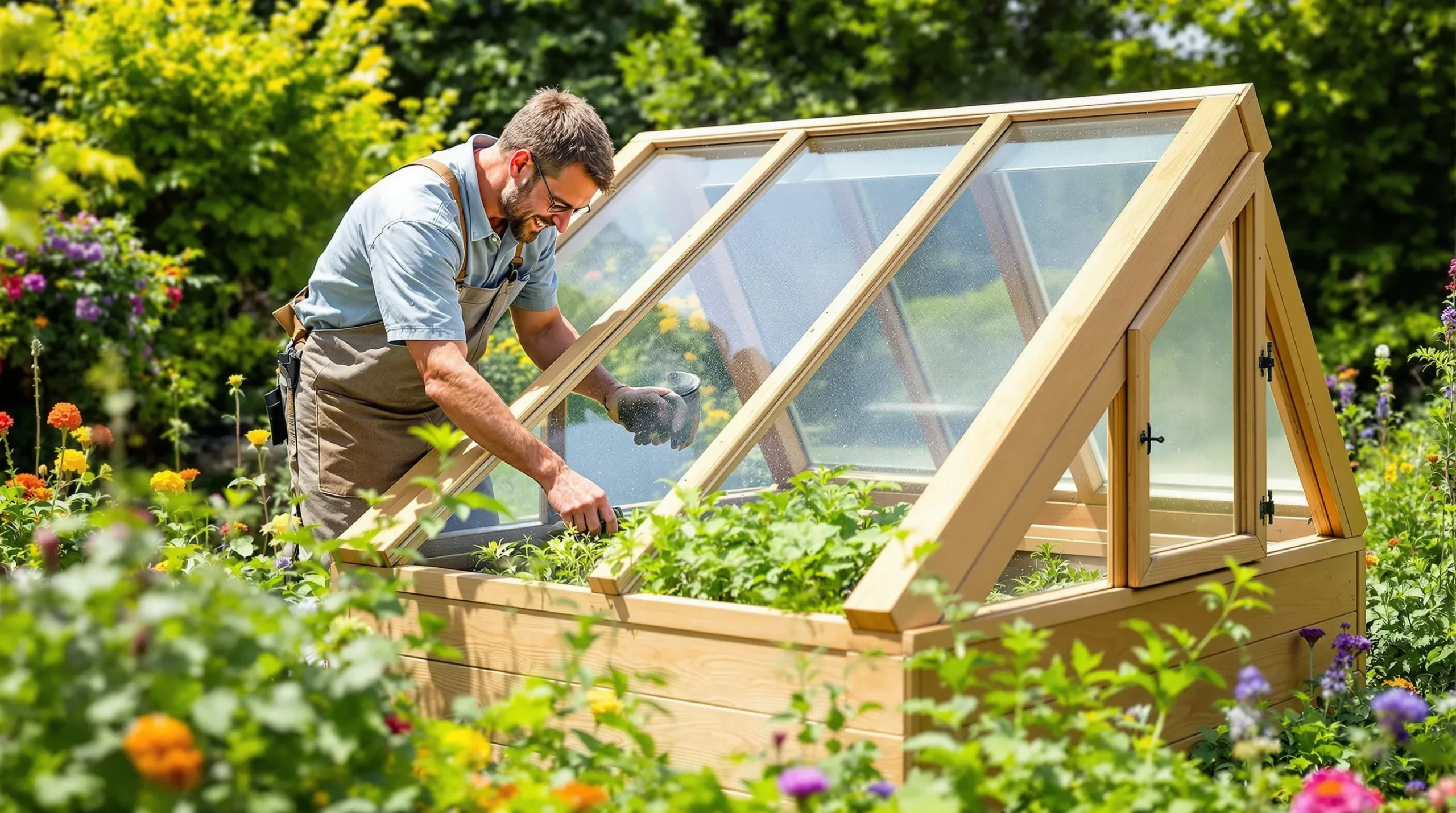
How to Make a Cold Frame: Complete DIY Guide for Year-Round Growing
Learn how to make a cold frame to extend your growing season, protect plants in winter, and grow seedlings all year. Simple, cost-effective, and DIY-friendly!
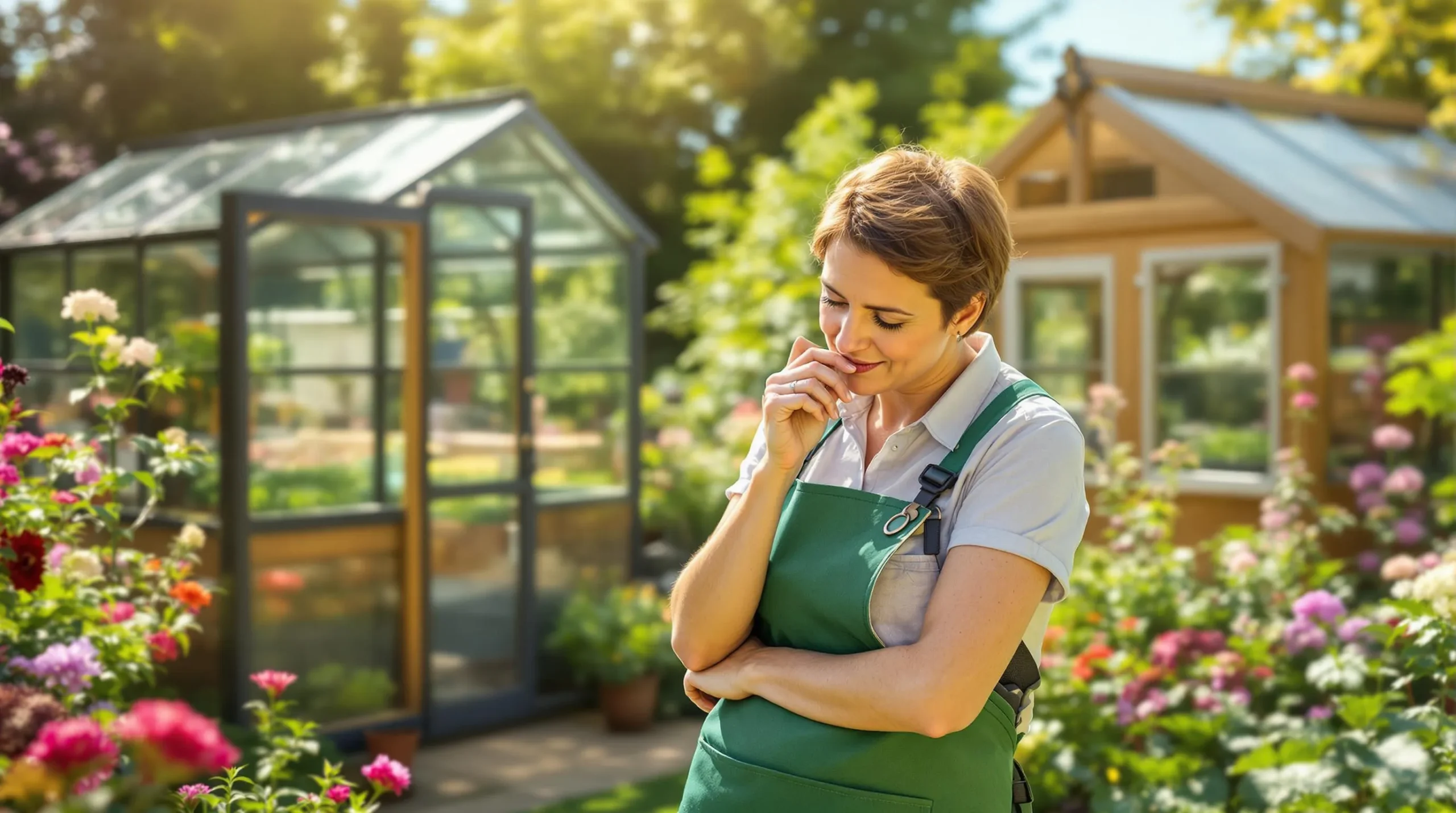
Starting your greenhouse journey can feel overwhelming when you’re staring at endless options online or wandering through garden centres. You’ve probably dreamed of growing your own tomatoes year-round or nurturing delicate seedlings through harsh winters, but the sheer variety of sizes, materials, and features available can make your head spin.
The truth is, your first greenhouse doesn’t need to be perfect – it just needs to suit your space, budget, and growing ambitions. Whether you’re working with a tiny urban balcony or a sprawling countryside garden, there’s a greenhouse solution that’ll transform your gardening game.
Making the right choice now will save you costly mistakes later and set you up for years of successful growing seasons ahead.
Greenhouse gardening extends your growing season beyond natural limitations. Spring planting starts 6-8 weeks earlier with greenhouse protection, whilst autumn harvests continue 4-6 weeks longer than outdoor gardens. This extended timeline delivers 2-3 additional months of productive growing time each year.
Temperature control protects plants from weather extremes. Frost damage eliminates outdoor crops when temperatures drop below 0°C, but greenhouses maintain stable conditions between 10-25°C throughout winter months. Summer heatwaves above 30°C stress outdoor plants, yet greenhouse ventilation systems regulate internal temperatures automatically.
Year-round food production becomes achievable with proper greenhouse management. Lettuce varieties like ‘Winter Gem’ and ‘Arctic King’ produce fresh leaves during December and January. Tomato plants continue fruiting until November when grown in heated greenhouse environments. Root vegetables including carrots and radishes mature in 45-60 days during winter months under glass protection.
Physical barriers eliminate common garden pests without chemical treatments. Aphids, slugs, and caterpillars cannot reach plants inside sealed greenhouse structures. Cabbage white butterflies lay eggs on outdoor brassicas but cannot access greenhouse-grown specimens. Bird damage affects 15-20% of outdoor fruit crops, whilst greenhouse protection maintains 100% of harvests.
Weather protection prevents crop losses from storms and hail. Summer storms destroy 30-40% of outdoor vegetable gardens annually, but greenhouse walls deflect wind speeds up to 80mph. Hailstones damage leaf surfaces and bruise fruits in exposed gardens, yet glass or polycarbonate panels absorb impact completely.
Humidity regulation creates optimal conditions for different plant types. Tropical plants like orchids require 60-80% humidity levels, easily maintained inside greenhouse environments. Mediterranean herbs including rosemary and thyme prefer 40-50% humidity, controlled through ventilation adjustments. Seed germination rates improve by 25-35% when humidity stays consistent between 65-75%.
Light management extends productive hours during short winter days. Natural daylight lasts only 7-8 hours during December in the UK, but supplemental LED grow lights provide 12-14 hours of photosynthetic activity. Seedlings grown under controlled lighting conditions develop 40% stronger root systems compared to windowsill alternatives.
Soil quality control eliminates contamination and disease issues. Greenhouse growing uses sterile compost mixtures free from soil-borne pathogens like clubroot and blight. Container gardening inside greenhouses prevents nutrient depletion common in outdoor beds. pH levels stay balanced between 6.0-7.0 through controlled watering and fertilisation programmes.
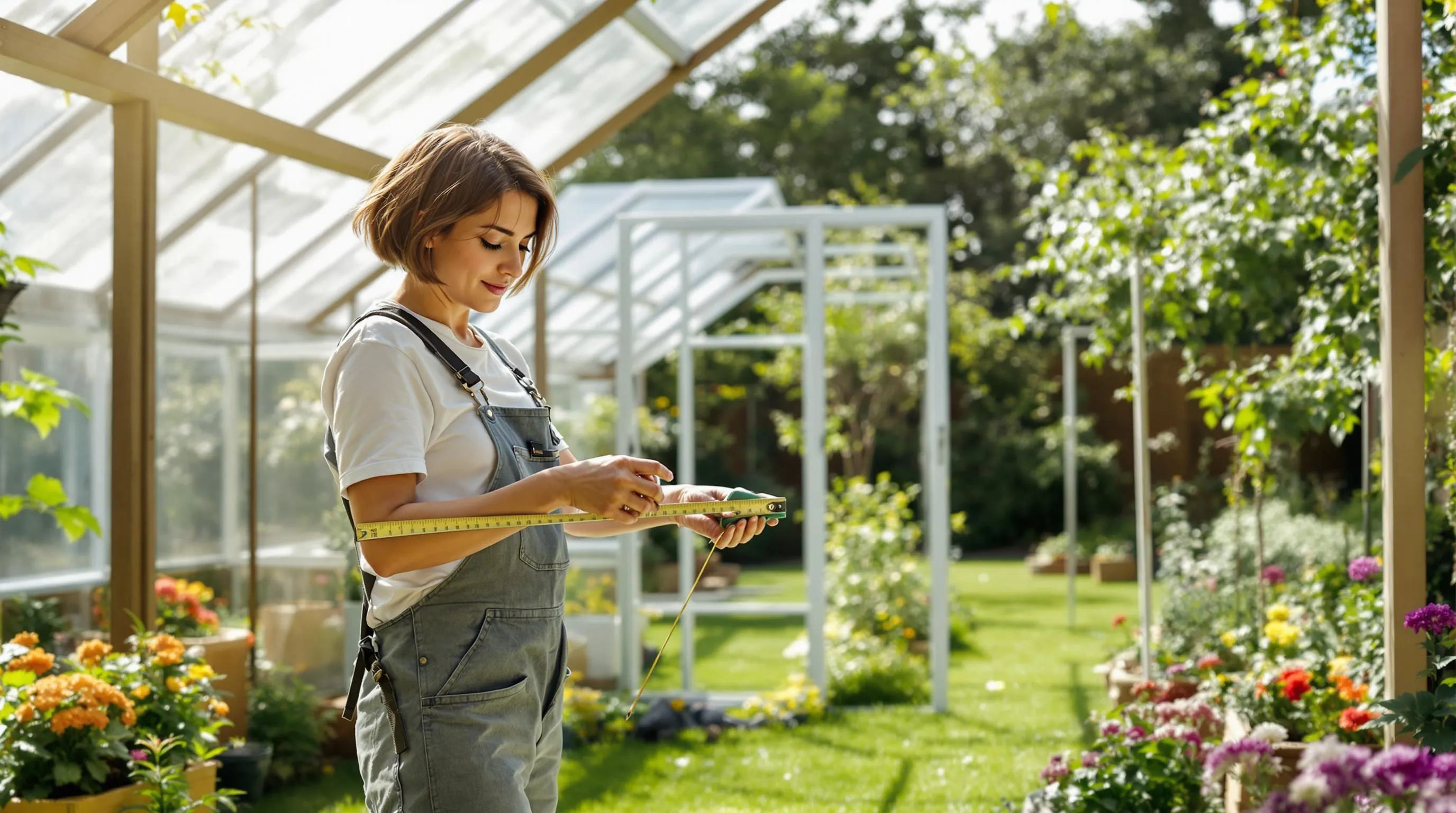
Selecting the optimal location for your greenhouse involves three critical evaluations. Each factor directly impacts plant growth success and long-term maintenance requirements.
Measure your garden space precisely before selecting a greenhouse size. Start by identifying the exact footprint available for installation. Record length and width measurements in metres to compare against greenhouse specifications.
Factor access pathways into your calculations. Leave 1.5 metres clearance around the structure for maintenance tasks such as cleaning glass panels or replacing components. Most gardeners underestimate space requirements and later struggle with restricted access.
Consider your current and future growing ambitions when determining size. A 2.4m x 3m greenhouse accommodates 12-15 tomato plants or equivalent mixed vegetables. Expanding your greenhouse later costs significantly more than purchasing adequate space initially.
Plan for foundation materials within your measurements. Concrete bases require additional 150mm beyond the greenhouse footprint on all sides. Paving slabs or timber frameworks need similar allowances for proper installation.
Position your greenhouse to capture maximum daily sunlight hours. South-facing orientations receive optimal light throughout growing seasons. Southeast positioning works effectively as a secondary option.
Observe your garden throughout different seasons to identify consistent light patterns. Trees cast longer shadows during winter months when greenhouse plants require every available photon. Buildings and fences create permanent shade zones that severely limit plant growth.
Document 6-8 hours of direct sunlight as your minimum requirement. Shaded locations reduce plant yields by 40-60% compared to well-lit positions. Lettuce tolerates partial shade while tomatoes and peppers demand full sun exposure.
Check for seasonal obstructions that affect light availability. Deciduous trees appear harmless during winter planning but create dense shade during crucial growing months. Neighbouring construction projects or growing hedges alter light patterns over time.
Evaluate practical access routes for both installation and daily use. Greenhouse panels arrive on large delivery vehicles requiring clear pathways to your chosen location. Measure gate widths and path clearances to prevent delivery complications.
Plan for regular maintenance access around the entire structure. Cleaning exterior glass panels requires ladder access and adequate working space. Ventilation adjustments and repairs become impossible with restricted access.
Position your greenhouse within 30 metres of your water supply for convenient irrigation. Running water lines beyond this distance increases installation costs significantly. Gravity-fed watering systems work effectively with elevated water sources.
Consider electrical supply requirements for heating and lighting systems. Standard domestic circuits accommodate most greenhouse electrical loads. 13-amp weatherproof sockets provide adequate power for heaters, fans and growing lights.
Assess drainage patterns around your proposed location. Water pooling damages foundations and creates maintenance problems. Slight slopes away from the structure prevent water accumulation and foundation settling.
Plan material storage space near your greenhouse location. Compost bags, plant pots and gardening tools require weatherproof storage within easy reach. Tool storage reduces daily walking distances and improves gardening efficiency.
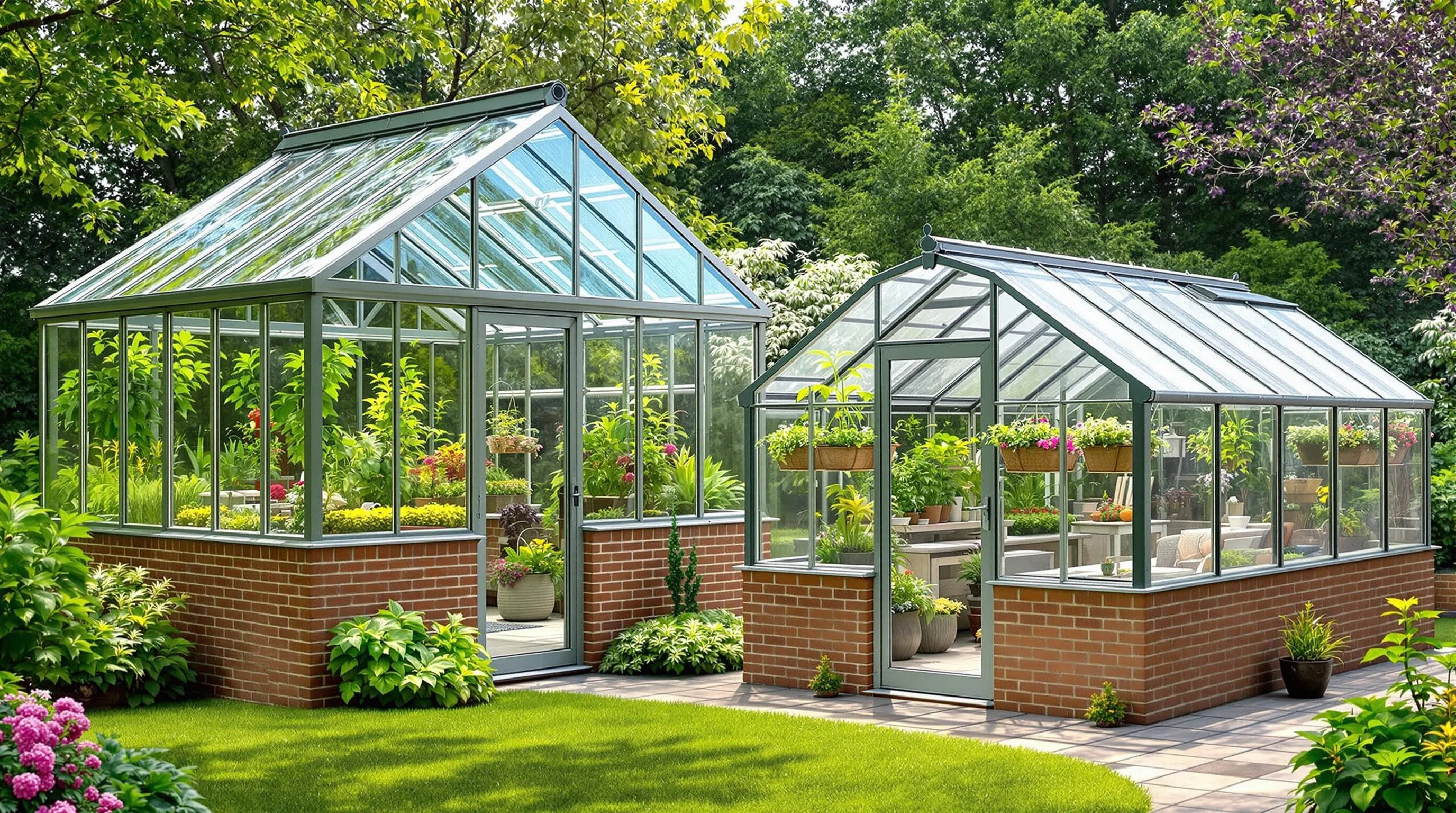
Selecting the right greenhouse type forms the foundation of your growing success. Each structure offers distinct advantages that align with different gardening goals, space constraints, and budget considerations.
Freestanding greenhouses provide maximum flexibility and growing space for your gardening ambitions. These independent structures stand alone in your garden, offering 360-degree access for maintenance and plant care.
Position your freestanding greenhouse facing south or southeast to capture optimal sunlight throughout the day. You gain the freedom to place the structure anywhere in your garden that meets sunlight requirements and avoids shade from trees or buildings.
Foundation requirements include concrete or paving stones for stability and weather resistance. This solid base prevents shifting during strong winds and ensures your greenhouse remains level for proper door operation.
Most freestanding models range from 6×8 feet to 12×20 feet, accommodating everything from hobby growing to serious food production. The larger footprint allows for proper spacing between plants, dedicated areas for seed starting, and storage space for tools and supplies.
Cost considerations typically range from £300-£3000 depending on size and materials. Whilst freestanding greenhouses require higher initial investment, they offer the best long-term value for dedicated gardeners.
Lean-to greenhouses attach directly to your house or garden building, sharing one wall to reduce construction costs and maximise space efficiency. This design makes excellent use of limited garden areas whilst providing convenient access from your home.
Shared wall construction provides additional insulation that helps maintain stable temperatures year-round. Your greenhouse benefits from heat radiating from the house wall, reducing heating costs during colder months.
Installation requires less site preparation compared to freestanding structures since one wall already exists. You only construct three sides, making lean-to greenhouses quicker to build and more affordable for beginners.
Position lean-to greenhouses on south-facing walls to ensure adequate sunlight reaches your plants. Avoid north-facing walls that create shadowed growing conditions throughout most of the day.
Typical dimensions range from 4×8 feet to 8×12 feet, perfect for small gardens or urban growing spaces. The compact design still accommodates substantial growing capacity whilst fitting into tight spaces.
Polytunnels consist of metal hoops covered with flexible plastic sheeting, creating an affordable entry point into protected growing. These structures cost significantly less than rigid greenhouses whilst providing effective crop protection.
Construction takes 1-2 days with basic tools since polytunnels use simple assembly methods. The flexible framework allows for various lengths, from 10 feet to 100 feet or more, depending on your growing requirements.
Plastic covering lasts 4-6 years before requiring replacement, making polytunnels cost-effective for budget-conscious gardeners. UV-stabilised polythene provides good light transmission whilst protecting plants from wind and rain.
Ventilation occurs through roll-up sides that you adjust based on weather conditions. This system provides excellent airflow control during hot summer months whilst maintaining protection during storms.
Polytunnels excel for vegetable production and season extension rather than year-round growing. They suit gardeners focusing on crops like lettuce, herbs, tomatoes, and soft fruits that benefit from wind protection.
Mini greenhouses offer portable growing solutions for beginners with limited space or those wanting to test greenhouse gardening before larger investments. These compact structures fit on patios, balconies, or small garden areas.
Assembly requires no foundation or site preparation since most mini greenhouses sit directly on existing surfaces. You can move these structures seasonally to follow optimal sunlight patterns in your garden.
Typical dimensions range from 2×2 feet to 4×6 feet, providing space for seed starting, herb growing, or protecting tender plants. The compact size makes them manageable for beginners learning greenhouse basics.
Protection from cold and pests represents the primary benefit of mini greenhouses. They create a microclimate that extends growing seasons by 4-6 weeks whilst shielding young plants from harsh weather.
Cost ranges from £50-£300 making mini greenhouses accessible for gardeners testing their interest in protected growing. Start with a smaller model to learn greenhouse management before investing in larger structures.
Growing capacity limits mini greenhouses to smaller crops like lettuce, herbs, microgreens, and seedlings. They work excellently as stepping stones toward larger greenhouse ownership whilst providing immediate growing benefits.

Greenhouse size directly impacts your growing capacity and gardening success. Selecting the correct dimensions prevents overcrowding whilst maximising your investment potential.
Small greenhouses suit beginners and compact gardens perfectly. These structures provide adequate space for herbs like basil and parsley, leafy greens such as lettuce and spinach, and compact crops including chillies and cherry tomatoes.
Consider your growing goals carefully before committing to compact dimensions. A 6×4 foot greenhouse accommodates approximately 8-12 medium-sized pots or 4-6 grow bags along the perimeter. Basic aluminium models start at £1,500, making them accessible entry points for new gardeners.
Space limitations become apparent quickly with intensive growing. You’ll find seed starting trays compete with mature plants for valuable bench space during peak growing seasons. These dimensions work best if you focus on 2-3 crop types rather than attempting diverse cultivation.
Maintenance remains straightforward in smaller structures. Temperature regulation requires less energy input, and pest monitoring becomes more manageable when plants remain within arm’s reach of all areas.
Medium greenhouses balance space efficiency with growing versatility. These dimensions accommodate taller crops like tomatoes and cucumbers whilst maintaining dedicated areas for seed propagation and herb cultivation.
Pricing reflects the increased materials and functionality. Wooden 6×8 foot structures start at £2,500, offering superior insulation properties compared to aluminium alternatives at similar dimensions.
Growing capacity expands significantly with medium sizing. An 8×6 foot greenhouse supports 15-20 medium containers or 8-10 large growing bags, plus dedicated staging for seedling development. This configuration enables crop rotation strategies and succession planting throughout the growing season.
Consider your physical capabilities when selecting medium dimensions. Reaching the centre areas requires stepping inside, and ventilation becomes more critical as internal air volume increases. These structures benefit from automated vent openers and circulation fans.
Seasonal flexibility improves with additional square footage. You can dedicate separate zones for different growing requirements – maintaining a heated propagation area whilst allowing cool-season crops to experience natural temperature fluctuations.
Large greenhouses transform gardening into comprehensive food production systems. These structures accommodate sprawling crops like melons and grape vines whilst maintaining dedicated spaces for year-round cultivation programmes.
Investment costs escalate substantially with increased dimensions. Prices typically exceed £5,000 before adding essential accessories like staging, heating systems, and automated ventilation equipment.
Growing potential reaches commercial-scale possibilities. A 10×12 foot greenhouse supports 30+ containers or enables ground-level bed cultivation for root vegetables and permanent plantings. These dimensions accommodate vertical growing systems and hanging basket arrangements.
Management complexity increases proportionally with size. Temperature gradients develop across larger spaces, requiring multiple thermostats and heating zones. Pest problems can establish more easily in expansive areas with numerous hiding spots.
Consider your long-term gardening ambitions before investing in large structures. These greenhouses suit experienced gardeners who understand climate control, pest management, and crop scheduling. Maintenance time commitments increase significantly compared to smaller alternatives.

Frame materials determine your greenhouse’s durability, maintenance requirements, and light transmission levels. Each material offers distinct advantages that affect your growing success and long-term costs.
Aluminium frames deliver exceptional durability with minimal maintenance across decades of use. The material resists corrosion in wet climates and maintains structural integrity through harsh weather conditions.
Light transmission increases significantly with aluminium frames compared to thicker materials. The thinner frame profile and glazing bars allow more sunlight to reach your plants throughout the day. This enhanced light penetration directly impacts plant growth rates and crop yields.
Maintenance costs remain low with aluminium structures. The material requires no painting, treatment, or weather protection over its lifespan. Basic cleaning removes dirt and debris from the frame surface.
Installation becomes easier due to aluminium’s lightweight properties. The reduced weight simplifies foundation requirements and makes assembly more manageable for first-time greenhouse owners.
| Aluminium Frame Features | Specifications |
|---|---|
| Weight | Lightweight construction |
| Maintenance frequency | Minimal – cleaning only |
| Light transmission | Maximum due to thin profile |
| Corrosion resistance | High in all climates |
| Price range | £1,500 for basic 6x4ft structure |
Wooden frames provide natural insulation properties that create stable internal temperatures for plant growth. The material absorbs harmful UV rays during the day and retains heat at night, extending your growing season effectively.
Temperature stability improves dramatically with wooden construction. The natural insulation reduces temperature fluctuations that stress plants and affect growth patterns. This thermal efficiency proves particularly valuable during transition seasons.
Aesthetic appeal makes wooden greenhouses attractive garden features. The traditional appearance complements most garden designs and property styles. Many gardeners choose wood specifically for its visual integration with outdoor spaces.
Maintenance requirements include regular treatment to prevent rot and weather damage. Wood contacts with moisture-holding surfaces create vulnerability points that require attention. Proper construction techniques eliminate ground contact and moisture retention issues.
Investment costs start higher than aluminium alternatives. Wooden greenhouse prices begin around £2,500 for a 6x8ft structure, reflecting the material costs and construction complexity.
Steel frames offer maximum structural strength for greenhouse applications requiring robust support systems. The material handles heavy snow loads, wind stress, and large glazing panels without deflection or failure.
Durability extends beyond other frame materials when properly treated. Galvanised or powder-coated steel prevents rust formation and maintains structural integrity for decades. The protective coating determines the frame’s lifespan in different climate conditions.
Foundation requirements increase with steel frame weight. The substantial material demands secure anchoring and level bases to prevent settling or movement. Installation complexity rises compared to lighter frame alternatives.
Maintenance focuses on coating integrity rather than structural issues. Regular inspection identifies coating damage before rust develops. Prompt treatment of damaged areas prevents structural compromise.
Cost considerations include both initial investment and foundation preparation. Steel frames require more substantial support systems, increasing overall project expenses beyond the frame price alone.
| Frame Material Comparison | Aluminium | Wood | Steel |
|---|---|---|---|
| Durability rating | High | Medium | Very High |
| Maintenance level | Low | High | Medium |
| Insulation properties | Low | High | Low |
| Weight category | Light | Medium | Heavy |
| Foundation requirements | Standard | Standard | Reinforced |

Glazing forms the transparent barrier that allows light into your greenhouse whilst maintaining the controlled environment inside. Your choice of glazing material significantly impacts light transmission, insulation, and long-term maintenance costs.
Traditional glass provides the highest light transmission at 90%, making it the premium choice for optimal plant growth. Tempered glass panels offer exceptional durability and resist impact damage better than standard glass alternatives.
Single-pane glass at 3mm thickness adequately supports most greenhouse applications, whilst 4mm thickness delivers enhanced strength and improved insulation properties. The crystal-clear surface maximises photosynthesis potential and creates an attractive visual appearance for your garden space.
Glass glazing withstands seasonal temperature fluctuations without degrading, maintaining consistent performance across multiple growing seasons. Aluminium frames complement glass panels perfectly, featuring thinner structural bars that maximise light entry whilst providing robust support.
Installation requires careful edge protection as impact damage can shatter entire panels. Tempered glass costs more initially than alternative materials but delivers superior scratch resistance and maintains clarity throughout its extended lifespan.
Polycarbonate panels offer excellent impact resistance with 40% better insulation than glass, making them ideal for harsh weather conditions and households with children. This lightweight material simplifies installation and reduces structural requirements for your greenhouse frame.
Twin-wall polycarbonate features internal air chambers that provide superior heat retention and structural strength compared to single-wall alternatives. The air spaces create natural insulation barriers that help maintain stable temperatures during seasonal changes.
Multi-wall polycarbonate panels provide beneficial light diffusion, spreading illumination evenly throughout your growing space. This diffused light reduces harsh shadows and creates more uniform growing conditions for your plants.
Polycarbonate maintains performance for 15+ years in most climates, though UV exposure can cause gradual discolouration over time. Triple-wall variants offer enhanced strength for snow loads and extreme weather conditions in colder regions.
Cost advantages make polycarbonate attractive for budget-conscious gardeners whilst still delivering professional-grade performance. The material blocks slightly more light than glass but compensates with superior thermal efficiency.
Plastic sheeting represents the most affordable glazing option with lightweight properties that simplify installation on basic frame structures. This flexible material suits temporary greenhouse setups and budget-conscious beginners exploring greenhouse gardening.
Single-layer plastic provides basic weather protection but offers limited insulation and light transmission compared to rigid alternatives. The material’s flexibility allows easy replacement but requires more frequent maintenance cycles.
UV exposure degrades plastic sheeting rapidly, typically requiring replacement every 2-3 years depending on climate conditions. This ongoing replacement cost can offset initial savings over extended periods.
Plastic sheeting works effectively for season extension purposes but lacks the durability for year-round growing operations. The material suits polytunnel applications and temporary growing structures where permanent installation isn’t required.
Installation involves securing plastic firmly to prevent wind damage whilst allowing for thermal expansion during temperature changes. Proper tensioning prevents flapping that can cause premature wear and tear.
| Glazing Type | Light Transmission | Insulation | Durability | Cost Level |
|---|---|---|---|---|
| Glass | 90% | Standard | 20+ years | High |
| Polycarbonate | 85% | 40% better than glass | 15+ years | Medium |
| Plastic Sheeting | 80% | Minimal | 2-3 years | Low |
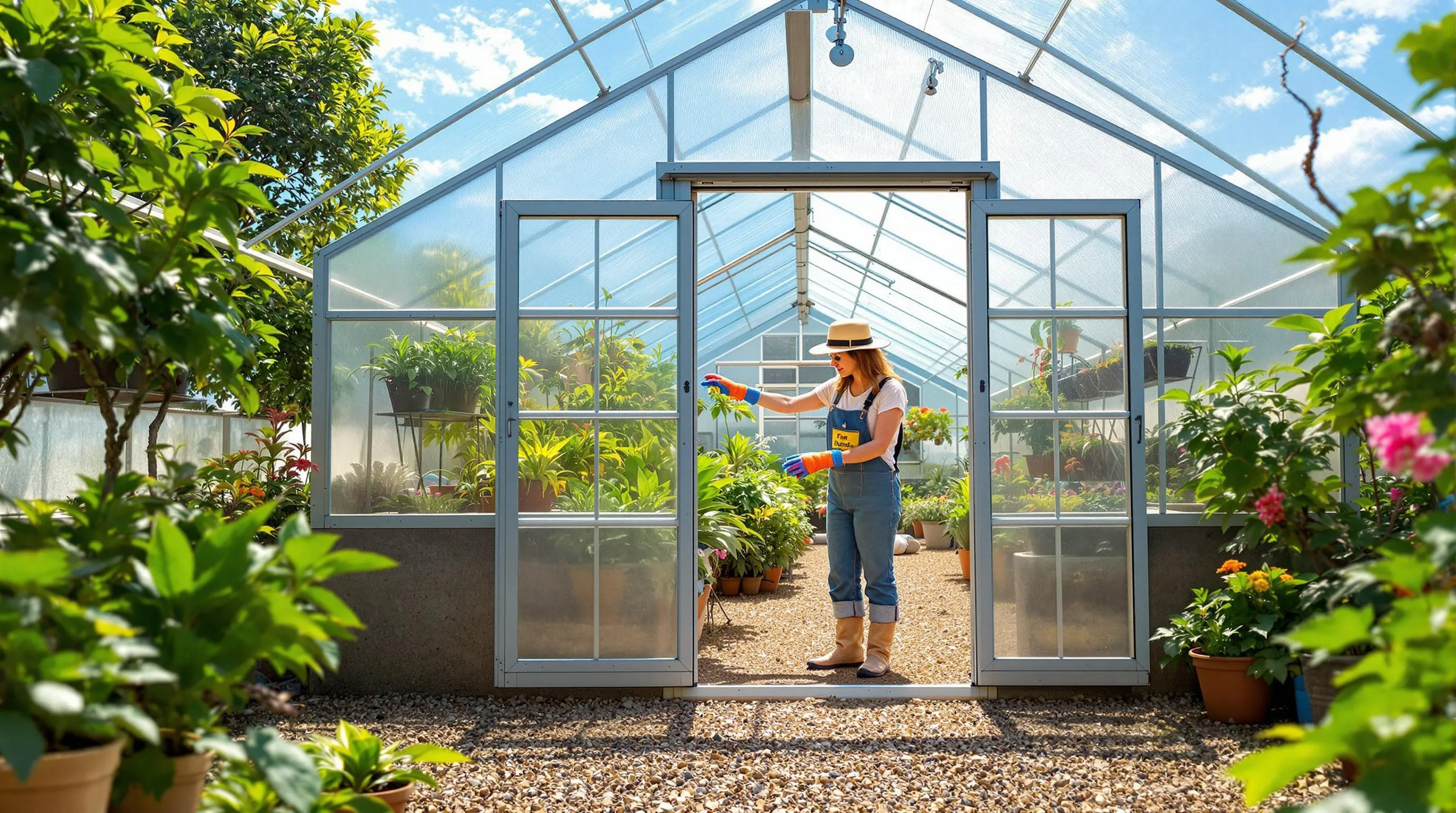
Choosing a greenhouse involves evaluating core features that determine your growing success. Focus on three critical elements that directly impact plant health and long-term satisfaction.
Proper ventilation controls temperature and prevents disease by maintaining optimal air circulation throughout your greenhouse. Temperature regulation becomes effortless when air moves freely through strategically placed vents.
Passive ventilation operates through natural airflow between roof and side vents. Wind and temperature differences create automatic air movement without electricity costs. Roof vents release hot air while side vents draw in cool air, creating constant circulation. This system works best in moderate climates where temperature swings remain gentle.
Active ventilation uses fans to force air movement when natural circulation proves insufficient. Series ventilation places fans in sequence, creating air loops that benefit low to medium-height plants like lettuce and herbs. Parallel ventilation positions fans side by side, pushing air across taller crops like tomatoes towards walls where it returns at root level.
Horizontal circulation fans eliminate hot spots by moving air sideways across your growing area. These fans prevent stagnant pockets where fungal diseases develop and ensure uniform temperature distribution. Position 2-3 fans in a 10×8 foot greenhouse for optimal coverage.
| Ventilation Type | Power Source | Installation Cost | Best For |
|---|---|---|---|
| Passive vents | Natural airflow | £50-150 | Mild climates |
| Exhaust fans | Electric | £100-300 | Hot summers |
| Circulation fans | Electric | £80-200 | Disease prevention |
Double doors provide superior access and airflow compared to single door configurations. Wide openings accommodate wheelbarrows and large plants while creating natural ventilation paths during hot weather.
Sliding doors save precious space around your greenhouse perimeter. These doors eliminate swing clearance requirements, making them perfect for tight garden spaces or greenhouses positioned near boundaries. Sliding mechanisms operate smoothly for 10-15 years with minimal maintenance.
Hinged doors offer superior sealing against weather and pests. Rubber seals compress tightly when closed, maintaining internal climate control and blocking insect entry. Choose doors with adjustable hinges to compensate for ground settling over time.
Weather sealing determines climate control effectiveness inside your greenhouse. Quality door seals prevent heat loss during winter and maintain humidity levels during summer. Inspect seal condition annually and replace worn sections to maintain optimal growing conditions.
Level foundations ensure structural integrity and prevent frame distortion that leads to glazing damage. Unlevel bases create stress points where panels crack and seals fail, compromising your greenhouse investment.
Concrete slabs provide maximum stability but require professional installation costing £300-800 depending on size. Concrete foundations last 25+ years and support heavy snow loads without settling. Incorporate drainage channels around perimeters to prevent water pooling.
Treated timber bases offer moderate stability at £150-400 installation cost. Pressure-treated softwood resists rot for 10-15 years when properly maintained. Level timber frames using adjustable feet to accommodate minor ground irregularities.
Gravel foundations balance cost and drainage while providing adequate support for smaller greenhouses. Compact gravel bases cost £100-250 and allow excellent water infiltration. Extend gravel 6 inches beyond greenhouse dimensions to prevent erosion and improve stability.
| Foundation Type | Cost Range | Lifespan | Drainage |
|---|---|---|---|
| Concrete slab | £300-800 | 25+ years | Poor |
| Timber frame | £150-400 | 10-15 years | Moderate |
| Gravel base | £100-250 | 5-10 years | Excellent |
Drainage prevents waterlogging that damages plants and creates pest breeding grounds. Grade foundations with 1-inch slope per 8 feet to direct water away from growing areas. Install perimeter drains around concrete foundations to manage heavy rainfall.
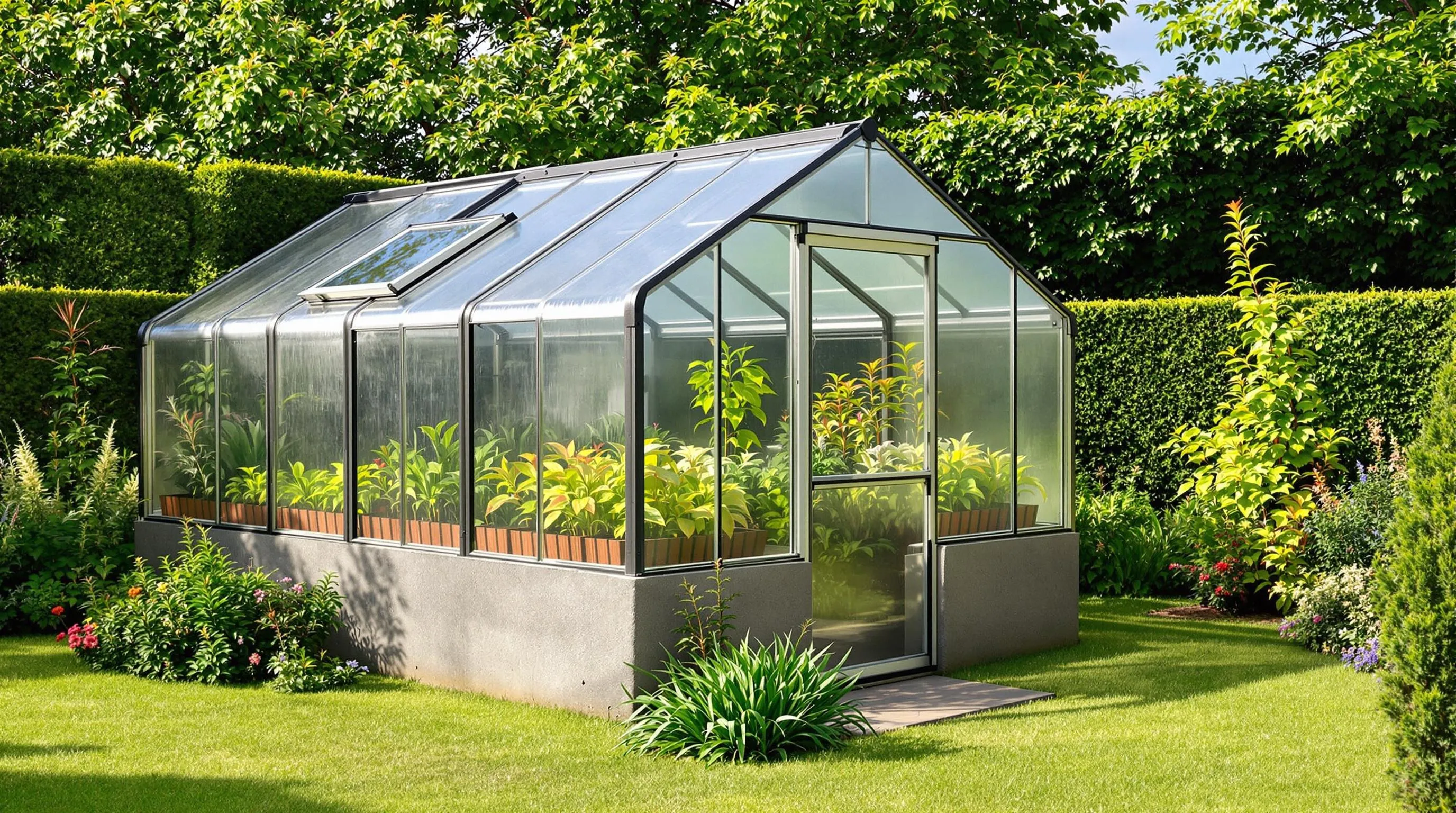
Proper planning transforms your greenhouse dreams into gardening success. Consider your growing goals, available space, and long-term vision before making any decisions.
Location determines 80% of your greenhouse’s success. Select a site that receives 6-8 hours of direct sunlight daily, ideally positioned facing south or southeast to capture maximum morning and afternoon sun.
Examine your garden throughout different seasons to identify potential shade sources. Trees, buildings, and fences cast shadows that change with the sun’s path, particularly during autumn and winter months when shadows extend further.
Level ground reduces foundation costs and installation time. Sloped sites require extensive preparation work, adding £200-500 to your project budget. Measure the area using a spirit level to confirm the ground variation stays within 15cm across the entire footprint.
Water access proves essential for daily plant care and automatic irrigation systems. Position your greenhouse within 30 metres of your main water supply or outdoor tap to avoid costly pipe extensions. Electricity access enables heating systems, grow lights, and ventilation fans that expand your growing possibilities.
Consider prevailing wind patterns when selecting your spot. Strong winds increase heating costs and can damage lightweight structures. Natural windbreaks like hedges or solid fences positioned 3-4 metres away provide protection without creating shade.
A level, stable foundation prevents structural problems and extends your greenhouse lifespan. Choose from three main foundation types based on your budget and local conditions.
Concrete slab foundations offer the strongest, most permanent option costing £8-12 per square metre. These bases last 25+ years and provide excellent stability for larger greenhouses over 3×2 metres. Concrete requires 3-7 days curing time before installation can begin.
Treated timber frames using cedar or redwood create a mid-cost solution at £5-8 per square metre. These foundations suit smaller greenhouses and can be installed in 1-2 days. Timber bases last 10-15 years with proper maintenance and drainage.
| Foundation Type | Cost per m² | Lifespan | Installation Time | Drainage |
|---|---|---|---|---|
| Concrete Slab | £8-12 | 25+ years | 3-7 days | Excellent |
| Treated Timber | £5-8 | 10-15 years | 1-2 days | Good |
| Gravel Base | £3-5 | 5-10 years | Same day | Superior |
Avoid placing your greenhouse directly on soil as this creates air gaps that allow pests, drafts, and moisture problems. Ground-level installation also reduces interior headroom and makes cleaning difficult.
Excavate the area 10cm deeper than your chosen foundation thickness. Add a 5cm layer of sharp sand or hardcore for drainage before laying your chosen base material. Ensure the finished surface sits 5-10cm above surrounding ground level to prevent water pooling.
Think beyond your current gardening ambitions when selecting greenhouse size and features. Most greenhouse owners expand their growing activities within 2-3 years of starting, often requiring additional space or equipment.
Choose modular greenhouse designs that allow extensions without replacing the entire structure. Many aluminium frame systems offer expansion kits that attach to existing end walls, doubling your growing space for 60-70% of the original cost.
Plan your internal layout using adjustable shelving systems rather than fixed benches. Removable staging allows you to accommodate tall plants like tomatoes and peppers as your confidence grows. Reserve floor space for larger containers and potential future features like propagation areas or potting benches.
Consider your physical capabilities when planning long-term use. Greenhouse maintenance increases with size, requiring more time for cleaning, ventilation management, and plant care. A 2×3 metre greenhouse takes 2-3 hours weekly maintenance, while a 3×4 metre structure requires 4-5 hours.
Budget for future accessories and upgrades when making your initial purchase. Automatic vent openers, heating systems, and irrigation equipment often cost £200-400 additional but significantly improve growing success and reduce daily maintenance time.
Position your greenhouse to allow access for future service connections. Leave 1-2 metres clearance on at least one side for potential water, electricity, or gas line installations. This forward planning prevents costly relocation or extensive excavation work later.
Budget planning determines the greenhouse purchase that fits your gardening goals and financial capacity. The total cost encompasses three main areas that impact your long-term gardening success.
Greenhouse prices vary significantly based on size and style. Small basic models range from £200-£600, while medium traditional greenhouses cost £800-£2,000. Large structures with additional features like integrated storage or potting sheds reach £3,000-£6,000 or more.
Size directly affects your growing capacity and value. A 6×4 foot greenhouse accommodates 20-30 small plants, while an 8×6 foot structure supports 40-50 plants plus seed trays. Consider your current needs and expansion plans when selecting dimensions.
Material quality influences pricing structure. Aluminium frames with polycarbonate glazing typically cost 20-30% more than basic steel alternatives but offer superior durability and insulation. Glass-glazed greenhouses command premium prices due to optimal light transmission and longevity.
Combination greenhouses with built-in storage cost 25-40% more than standard models but eliminate separate shed requirements. Lean-to designs attached to existing walls reduce material costs by approximately 15-20% compared to freestanding structures.
Foundation requirements represent the largest installation cost. A concrete base for an 8×6 foot greenhouse costs £300-£600 including materials and labour. Treated timber frames range from £150-£300, while gravel foundations cost £100-£200.
Professional installation adds £200-£800 depending on greenhouse size and complexity. Simple structures on prepared bases require 4-6 hours of assembly time. Complex models with multiple ventilation systems or integrated features need 8-12 hours.
Site preparation costs vary by location conditions. Level ground requires minimal preparation, while sloped areas need excavation and levelling costing £200-£500. Tree removal or ground clearance adds £100-£300 to total expenses.
Utility connections increase installation budgets. Water supply extension costs £150-£400 depending on distance from main lines. Electrical installation for lighting and heating systems ranges from £200-£600 including safety certification.
Annual maintenance expenses typically equal 3-5% of initial purchase price. A £1,500 greenhouse requires £45-£75 yearly for routine upkeep including cleaning supplies, replacement parts, and minor repairs.
Glazing maintenance represents the primary ongoing cost. Glass panel replacement costs £15-£30 per panel, while polycarbonate sections range from £20-£40. Annual cleaning products and tools cost £25-£50 for most greenhouse sizes.
Heating expenses vary dramatically by usage and insulation. Electric heaters consume 1-3 kW per hour, costing £150-£400 annually for winter protection. Insulation upgrades reduce heating costs by 30-50% but require £100-£200 initial investment.
Ventilation system maintenance includes motor servicing (£30-£50 annually) and automatic vent arm replacement every 3-5 years (£40-£80 per unit). Manual vents require minimal maintenance beyond occasional hinge lubrication.
| Cost Category | Small Greenhouse | Medium Greenhouse | Large Greenhouse |
|---|---|---|---|
| Initial Purchase | £200-£600 | £800-£2,000 | £3,000-£6,000 |
| Foundation | £100-£300 | £200-£500 | £400-£800 |
| Installation | £200-£400 | £300-£600 | £500-£1,000 |
| Annual Maintenance | £20-£40 | £40-£80 | £80-£150 |
| Annual Heating | £50-£150 | £100-£300 | £200-£500 |
Water supply costs remain minimal at £20-£40 annually for most growing operations. Pest control measures add £15-£30 yearly for organic treatments and monitoring systems.
New greenhouse owners frequently make predictable errors that limit their gardening success and create unnecessary expenses. Recognising these common pitfalls helps you make better decisions from the start.
Selecting a greenhouse that is too small represents the most frequent regret among first-time owners. Greenhouse gardening expands your growing ambitions quickly once you experience the extended seasons and controlled environment benefits.
Typical hobby greenhouses range from 6′ x 8′ for smaller spaces to 10′ x 12′ or larger for spacious gardens. Most gardeners discover they outgrow their initial greenhouse within 2-3 growing seasons as they experiment with different crops and growing techniques.
Choose the largest greenhouse that comfortably fits your available space to optimise growing potential and accommodate future expansion plans. A larger structure provides flexibility for varied plants including tall crops like tomatoes and climbing cucumbers alongside shorter vegetables and seedling areas.
Consider these space requirements for popular greenhouse crops:
| Crop Type | Space Required | Growing Season |
|---|---|---|
| Tomatoes | 18-24 inches between plants | March-October |
| Cucumbers | 12-18 inches spacing | April-September |
| Lettuce | 6-8 inches apart | Year-round |
| Herbs | 8-12 inches spacing | Year-round |
Positioning your greenhouse incorrectly dramatically reduces plant growth and increases heating costs throughout the year. The greenhouse location determines sunlight exposure duration and protection from harsh weather conditions.
Site your greenhouse where it receives maximum sunlight with southern exposure away from large trees or buildings that cast shadows. Greenhouse plants require 6-8 hours of direct sunlight daily for optimal photosynthesis and fruit production during peak growing months.
Avoid these common placement errors:
Ensure good drainage and easy access for daily maintenance tasks including watering and harvesting. Poor drainage creates waterlogged foundations that damage the structure and promote fungal diseases in your growing environment.
Installing insufficient ventilation causes temperature fluctuations and humidity problems that stress plants and encourage disease development. Greenhouse temperatures can rise 20-30°C above outside temperatures on sunny days without proper air circulation.
Proper ventilation regulates temperature and humidity whilst maintaining optimal airflow around your plants. Stagnant air promotes fungal diseases like powdery mildew and botrytis that destroy crops and reduce harvest yields.
Look for greenhouses with these ventilation features:
Install ventilation capacity equal to 15-20% of your floor area to maintain optimal growing conditions year-round. Insufficient venting creates temperature swings that shock plants and reduce flowering and fruit set in productive crops like tomatoes and peppers.
Consider supplementary ventilation options including exhaust fans rated for greenhouse use and circulation fans that prevent dead air pockets around dense foliage areas.
Your greenhouse journey starts with understanding your unique needs and making informed decisions that align with your space budget and growing ambitions. Remember that even experienced gardeners started with their first greenhouse and learned through hands-on experience.
Take time to evaluate your garden space properly measure your available area and consider how different greenhouse types and sizes will serve your long-term goals. Don’t rush the decision-making process – investing in the right foundation materials and features from the start will save you money and frustration later.
Start planning your greenhouse setup today and you’ll soon be enjoying extended growing seasons better harvests and the satisfaction of year-round gardening success.
Greenhouse gardening extends your growing season by 2-3 months, allowing earlier spring planting and later autumn harvests. It provides temperature and humidity control, protects plants from extreme weather and pests, and enables year-round food production. You’ll also have better soil quality control and can manage light exposure during shorter winter days.
Small greenhouses (6×4 to 6×6 feet) suit beginners and compact gardens. Medium sizes (8×6 to 10×8 feet) offer versatility for various crops and are ideal for most gardeners. Large greenhouses (10×12 feet and above) support comprehensive food production but require more investment and maintenance. Consider your long-term gardening goals and physical capabilities.
Aluminium frames offer exceptional durability, low maintenance, and high light transmission, making them ideal for most gardeners. Wooden frames provide natural insulation and aesthetic appeal but require more maintenance. Steel frames offer structural strength but need substantial foundations and regular maintenance. Choose based on your budget, maintenance preferences, and local conditions.
Glass provides the highest light transmission (90%) and exceptional durability but costs more initially. Polycarbonate panels offer better insulation and impact resistance, making them suitable for harsh conditions. Plastic sheeting is the most affordable option but has limited durability and requires frequent replacement. Consider your budget and local weather conditions.
Choose a south-facing location for maximum sunlight exposure throughout the day. Ensure the area is level, well-drained, and protected from strong winds. Check for seasonal obstructions like trees or buildings that could create shade. Consider proximity to water and electrical supplies, and leave space for access pathways and future expansion.
A level foundation is essential for structural integrity. Concrete slabs offer the best durability (20+ years) but cost £300-800. Treated timber bases are more affordable (£100-300) with a 10-15 year lifespan. Gravel foundations are the cheapest option (£50-150) lasting 5-10 years but may have drainage issues.
Small greenhouses cost £200-800, medium ones £500-1,500, and large greenhouses £1,000-3,000+. Factor in installation costs (£200-1,000), foundation expenses (£50-800), and utility connections (£100-500). Annual maintenance typically costs £50-200, including heating, glazing upkeep, and pest control measures.
Avoid choosing a greenhouse that’s too small for future growing ambitions, as expansion is often costly. Don’t position it in shaded areas or where strong winds can cause damage. Ensure adequate ventilation to prevent overheating and disease. Poor foundation preparation and ignoring proximity to utilities are also common costly mistakes.
Late autumn and winter typically offer the best deals on greenhouses, as demand is lower. This timing also allows for installation during milder weather before the growing season begins. However, consider delivery times and installation schedules, as some suppliers may have longer lead times during off-peak seasons.
Most domestic greenhouses under 2.5 metres high don’t require planning permission in the UK, provided they’re not closer than 2 metres to property boundaries. However, regulations vary by location and property type. Always check with your local planning authority before installation, especially for larger structures or if you live in a conservation area.

Learn how to make a cold frame to extend your growing season, protect plants in winter, and grow seedlings all year. Simple, cost-effective, and DIY-friendly!
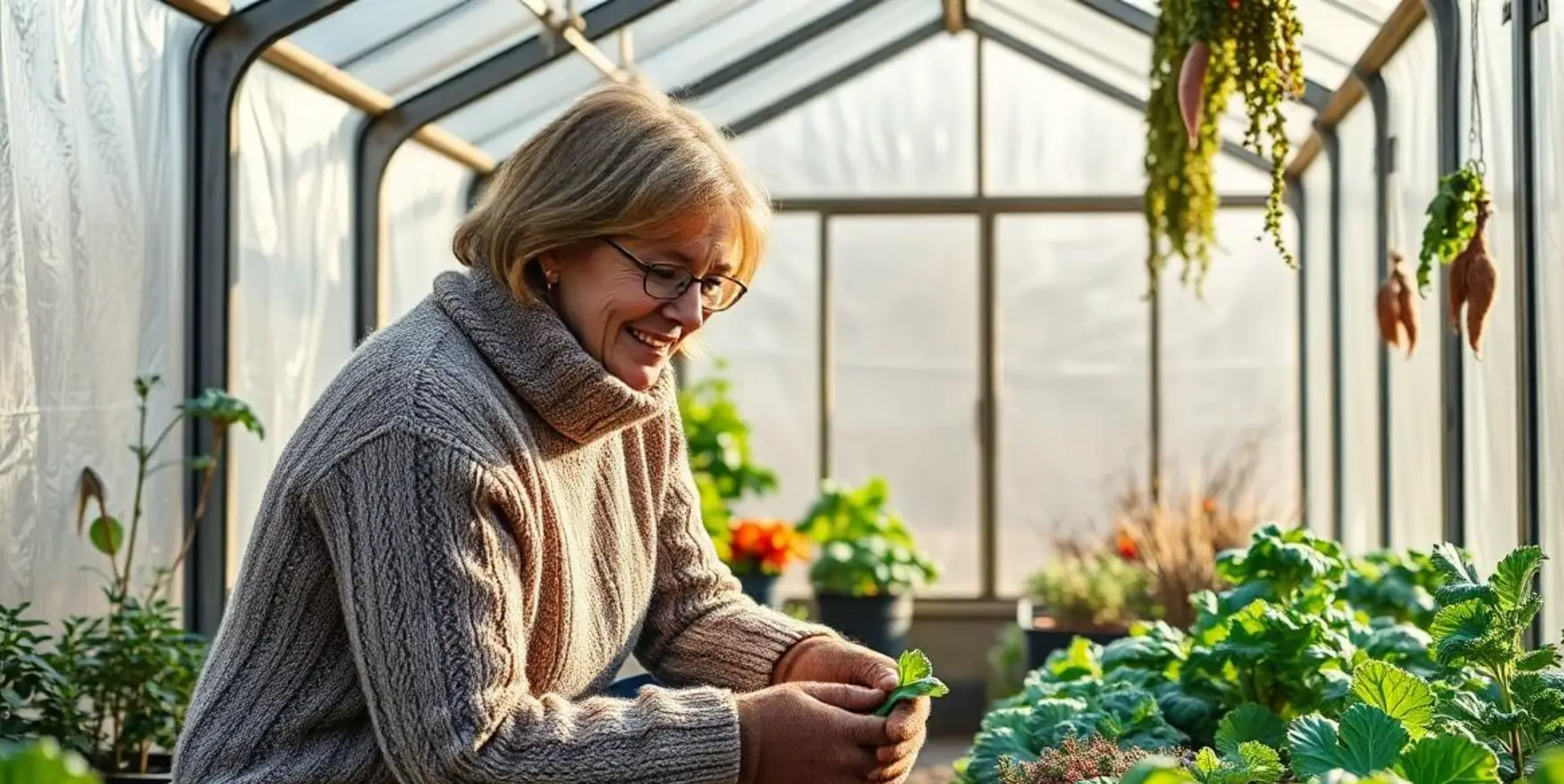
Key Takeaways Wondering if your greenhouse can remain productive during the frosty winter months? You’ll be delighted to know that